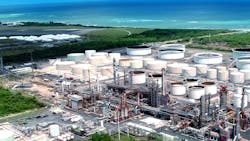Par Pacific-led jv to boost Hawaii’s sustainable aviation fuel supply
Key Highlights
- Par Pacific, Mitsubishi, and ENEOS formed Hawaii Renewables jv to build a 61-million-gal/year renewable fuels plant integrated into Par Pacific’s 94,000-b/d Kapolei refinery, advancing Hawaii’s low-carbon fuel supply.
- Plant to produce renewable diesel and sustainable aviation fuel (SAF) with flexible output up to 60% SAF, supporting Hawaii’s aviation decarbonization goals and regional GHG reduction.
- JV leverages Mitsubishi and ENEOS feedstock networks and US incentives to enhance project economics, with completion targeted by yearend 2025 and operations expected to begin first-quarter 2026.
Par Pacific Holdings Inc. has closed on formation of Hawaii Renewables LLC—a joint venture with Mitsubishi Corp. and ENEOS Corp.—for proposed construction and operation of a renewable fuels plant at Par Hawaii Refining LLC’s 94,000-b/d refinery in Kapolei, Oahu.
Initially announced in July 2025 and finalized in mid-October—the Hawaii Renewables JV marks a major step in Hawaii’s journey to expanding local renewable fuels production, geared specifically at supporting decarbonization of the island chain’s active aviation market.
Under the agreement, Mitsubishi and ENEOS, through their jointly owned Alohi Renewable Energy LLC, acquired a 36.5% equity stake in Hawaii Renewables for $100 million in cash. Par Pacific retained the remaining 63.5% ownership and will oversee completion and operation of the project through its subsidiary Par Hawaii Refining LLC.
Project scope, capacity
Already under construction, Hawaii Renewables’ proposed plant is designed to produce about 61 million gal/year (3,950 b/d) of renewable fuels, including renewable diesel, sustainable aviation fuel (SAF), renewable naphtha, and low-carbon LPG.
The project will integrate renewable fuels processing into the existing Kapolei refinery, allowing shared utilities, logistics, and distribution systems, creating a hybrid configuration that aims to reduce capital intensity compared with similar standalone plants of its kind.
Highlighting the project’s flexibility, Par Pacific said the plant will be able to adjust product yields between renewable diesel and SAF depending on market conditions, with potential SAF output of up to 60% of total capacity: a notable capability given Hawaii’s dependence on both aviation and inter-island marine transportation.
Feedstock pretreatment for the new plant will use Tennessee-based Lutros LLC’s proprietary technology, which is equipped to handle a range of waste oils and fats, providing optionality as global renewable feedstock markets tighten.
During its quarterly earnings call in August, Par Pacific said it was nearing mechanical completion and commissioning of the plant’s pretreatment unit.
With construction activities proceeding as planned, the Hawaii Renewables plant remains on schedule for final completion by yearend 2025.
Once online, the plant will be Hawaii’s largest, with the site’s SAF and renewable diesel production providing reliable transportation and utility fuel options to consumers and businesses while also contributing to reductions in regional greenhouse gas emissions (GHG).
Project feedstocks, rationale
While the partners did not reveal specific renewable feedstocks to be processed at the plant, Par Pacific indicated the strategic partnership will afford it with access to imported feedstock.
Alongside Par Pacific’s advantaged US West Coast (USWC) asset base and operational capabilities, Hawaii Renewables will benefit from access to Mitsubishi’s global feedstock procurement network, as well as its Petro-Diamond terminal in Long Beach, Calif., an important logistical link for renewable product distribution across the Pacific basin.
As Japan's leading energy company, ENEOS will similarly strengthen the partnership by leveraging its fuel refining and trading network across the Asia Pacific and North America to enhance feedstock-sourcing options.
The JV structure also will enable Hawaii Renewables to benefit from both US federal incentives—including the Renewable Fuel Standard (RFS) and Inflation Reduction Act tax credits—and California’s Low Carbon Fuel Standard (LCFS), given potential access to the USWC market via marine transport.
“[A]t the end of the day, we see our SAF project as very attractive relative to the industry, driven by our operating expense,” William Monteleone—Par Pacific’s director, president, and chief executive officer—said in August.
“Given that it's inside the fence line of the plant, on a per-gallon basis, we'd expect it to be very attractive and highly competitive,” Monteleone added.
Looking ahead, Monteleone said Par Pacific does not expect to see financial contributions from the JV until first-quarter 2026.
“Keep in mind, we'll be in commissioning and really getting through the credit pathway establishment. It's going to take us a quarter or two before we get to the right [carbon intensity] scores and, ultimately, to the run-rate contributions for [the new business],” he said.
The partners have yet to reveal specific margin guidance on the project.
Kapolei site overview
The Hawaii refinery’s major processing units produce LPG, naphtha, gasoline, jet fuel, ultralow-sulfur diesel, marine fuel, low-sulfur fuel oil, high-sulfur fuel oil, asphalt, and other associated refined products.
The site’s logistics network—which extends throughout the state—begins on Oahu with Par Pacific’s single-point mooring (SPM), 1.7 miles offshore from the refinery. The mooring enables the receipt of crude oil as well as both the receipt and export of finished products (Fig. 2). Connecting the SPM to the Hawaii refinery are three subsea pipelines, two for the import or export of refined products and one for crude oil.
Par Pacific also operates an onshore pipeline manifold to allow for crude transfers between the refinery and IES Downstream LLC’s storage site, about 2 miles away.
From the refinery, Par Pacific is able to distribute refined products via its logistics network of pipelines, trucks, leased barges, terminals, and storage installations across the islands of Oahu, Maui, Hawaii, Molokai, and Kauai, as well as shipping them to the USWC and Asia Pacific.
After averaging annual crude throughput rates of about 80,000 b/d between 2022-24, the Kapolei refinery ended second-quarter 2025 running at a near-nameplate capacity and quarterly record rate of 88,000 b/d. Works to “sustainably de-constrain” operations at the site during the previous 18 months brought about the change, including improving overall heater efficiency inside the refinery, Monteleone said in August.
About the Author
Robert Brelsford
Downstream Editor
Robert Brelsford joined Oil & Gas Journal in October 2013 as downstream technology editor after 8 years as a crude oil price and news reporter on spot crude transactions at the US Gulf Coast, West Coast, Canadian, and Latin American markets. He holds a BA (2000) in English from Rice University and an MS (2003) in education and social policy from Northwestern University.


